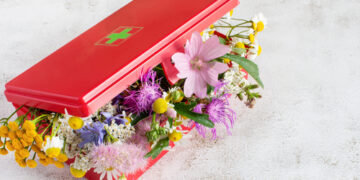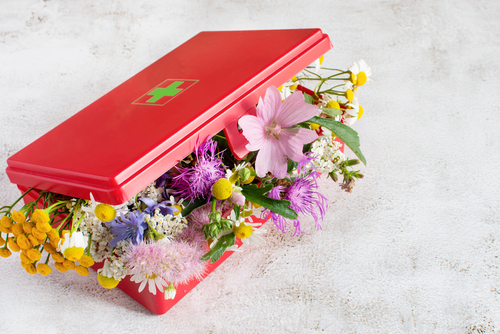A Kit That Feels Like a Hug
You know that feeling when someone hands you a warm cup of tea, tucks a blanket around your shoulders, and just gets what you need? That’s the kind of energy I like in a first aid kit. Not just quick fixes, but comfort. Not just bandages, but balms. A little jar of something that smells like lavender. A salve that you trust because it came from your own two hands—or from someone who cared enough to pass it down.
Sure, I’ve got a basic store-bought kit under the sink, with the sterile gauze and tweezers and all. But right next to it? A little basket of homemade and natural go-to’s that I’ve relied on more times than I can count. For cuts, burns, stings, itches, bruises, and those weird little rashes that show up outta nowhere—this kit has earned its spot on the shelf.
So if you’ve ever wanted to build a first aid setup that feels more like home and less like a sterile clinic, come sit with me a minute. Let’s walk through what you really want on hand when life happens.
[Ad Banner #1 Here]
Skin-Soothers and Wound-Healers
Let’s start with the stuff you’re going to reach for most: the comforters. The “ouch” relievers. The things you can rub, dab, or spread on a scrape and know it’s going to help, not sting.
Aloe Vera – The Cooling Hero
If you only keep one plant in your house, let it be aloe. That thick gel inside those spiky leaves is pure magic for burns, sunburns, insect bites, and general skin freak-outs. You don’t even have to do anything fancy—just snip off a leaf, slice it open, and squeeze the goo straight onto the skin.
Tip: Store cut aloe in the fridge for even more soothing power. If a live plant isn’t in the cards, grab a bottle of 100% aloe gel. Just check the label—avoid the ones with dyes, perfumes, and mystery ingredients.
Calendula Salve – Nature’s Bandaid
This is one I keep in a little tin in my bag and in the kitchen. Calendula is a bright orange flower that’s packed with healing properties. It’s anti-inflammatory, antimicrobial, and gentle enough for babies. You can use it on:
-
Scrapes and minor cuts
-
Dry, cracked hands
-
Chafing or skin irritation
-
Healing wounds that need moisture, not chemicals
Homemade version: Infuse dried calendula flowers in olive oil for 2-3 weeks in a sunny windowsill, then strain and mix with melted beeswax for a simple, healing salve. It smells like sunshine and comfort.
Lavender Essential Oil – A Calm in the Storm
This one’s not just for making things smell pretty. Lavender oil is calming for the skin and the nerves. Mix a drop or two with a carrier oil (coconut, sweet almond, even olive oil in a pinch) and dab it on:
-
Minor burns
-
Itchy bug bites
-
Tension headaches (a little on the temples)
-
Sleepless nights—rub a tiny bit on the wrists or chest
Clean and Protect
You need a few things in your kit to clean out wounds, stop the bleeding, and keep them from getting funky.
Tea Tree Oil – The Mighty Disinfectant
Tea tree’s got natural antibacterial and antifungal properties, so it’s a go-to for keeping cuts and scrapes clean. It’s strong stuff, though—never use it straight on skin. Mix 1–2 drops into a teaspoon of carrier oil and apply gently with a clean cotton swab or cloth.
It also works wonders on:
-
Athlete’s foot
-
Mild fungal rashes
-
Early signs of pimples or ingrown hairs
Witch Hazel – The Soothing Cleanser
Witch hazel is one of those old-timey remedies that deserves more love. It’s cooling, mildly astringent, and perfect for:
-
Cleaning cuts
-
Calming inflamed skin
-
Dabbing on bruises or insect bites
-
Soothing razor burn or hemorrhoids (yep, we’re going there)
Keep a little bottle in your kit and you’ll find a dozen uses for it. Just make sure it’s alcohol-free if your skin runs sensitive.
Raw Honey – Sweet and Healing
Honey—especially raw or local—isn’t just for tea. It’s antibacterial, keeps wounds moist (which helps them heal faster), and forms a natural barrier on cuts and burns.
To use it:
-
Clean the wound gently
-
Dab on a bit of honey
-
Cover with gauze or a clean bandage
-
Change daily and watch it do its thing
I’ve used it for cracked knuckles in winter, minor kitchen burns, and even stubborn scrapes that needed a little extra love.
[Ad Banner #2 Here]
Pantry Helpers and Everyday Must-Haves
Some of the best first aid tools aren’t from the health store—they’re in your kitchen.
Baking Soda – The Bite and Itch Tamer
A baking soda paste (just mix with a bit of water) will calm:
-
Mosquito bites
-
Bee stings
-
Mild allergic skin reactions
-
That mystery rash you think came from weeding the garden barefoot (just me?)
Apply it, let it sit 10–15 minutes, then rinse. You can also toss a handful into a warm bath for all-over relief.
Coconut Oil – The Overachiever
You’ll see this one a lot in natural remedies, and for good reason. It’s moisturizing, antimicrobial, gentle, and shelf-stable.
Use it on:
-
Dry skin
-
Healing cuts
-
Diaper rash
-
Chapped lips
-
As a base for homemade balms or salves
I even mix a little with tea tree and lavender oils for a multipurpose healing balm.
Tools That Make It All Work
It’s not all herbs and oils—you’ll want a few basics, too.
-
Bandages & gauze pads – All sizes, shapes, and stickiness levels
-
Medical tape – I like the soft, cloth kind that doesn’t yank your skin off
-
Tweezers – For splinters, stingers, and tiny emergencies
-
Scissors – Sharp, clean, and only for your kit
-
Gloves – A couple pairs of disposable ones for messy jobs
-
Digital thermometer – Helpful for checking fevers or when someone feels off
-
Reusable cold pack – For bumps, bruises, or headaches
Keep everything organized in a sturdy box or zippered pouch. Bonus points if it has sections or pockets. I like to add a little notebook and pen, too—for jotting down what you gave, when you gave it, or just a reminder to restock something you ran out of.
More Than a Kit—It’s a Comfort Corner
Stocking a natural first aid kit is about more than ingredients. It’s about care. It’s about knowing that when someone falls, or burns a finger, or breaks out in hives after picking blackberries, you’ve got something to help them feel better.
These little jars and tools—many of them homemade or passed down—aren’t just treatments. They’re traditions. They’re proof that healing doesn’t always come in a bottle with a long list of unpronounceables. Sometimes, it comes from lavender oil and a gentle hand.
Start Small, Build Slow, and Make It Yours
If this feels like a lot, don’t stress. You don’t need to gather everything in one go. Start with what you’ve got. Maybe it’s just a jar of coconut oil and a roll of gauze. Or maybe it’s aloe and baking soda. Add to it little by little. Over time, you’ll build a kit that feels like your own—a reflection of how you care, how you heal, and how you show up when someone’s hurting.
And if you’ve got a favorite remedy, a handmade salve recipe, or a tool you swear by, tell me. These kits aren’t just about products—they’re about shared wisdom.



























